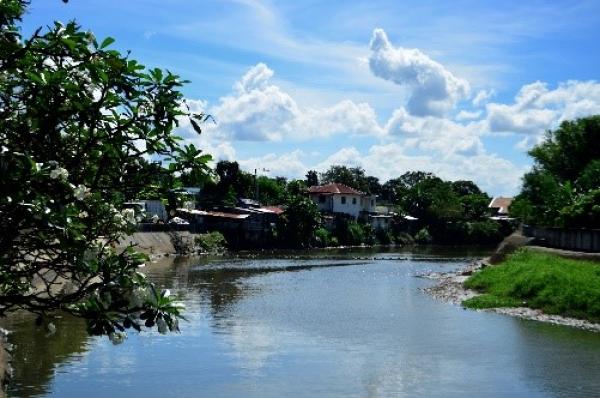PEMSEA Presents Actions to Rid Rivers of Plastic Waste for Earth Day
Tuesday, 19 April 2022

The Imus River originates from the upland streams of Silang and flows down to the ocean via Manila Bay. Combined, all segments of the river span 186.5 kilometers and pass through major towns and cities like Silang, Imus, Dasmariñas, Kawit and Bacoor, shown here. (Gregg Yan / PEMSEA)
MANILA, PHILIPPINES – To celebrate Earth Day 2022, PEMSEA (Partnerships in Environmental Management for the Seas of East Asia) released a set of studies to help manage plastic waste entering the world’s rivers.
The five studies were launched under Project ASEANO, a three-year initiative to stem the flow of plastic pollution in two pilot sites – the Imus River in the Philippines and the Citarum River in Indonesia. Funded by the Norwegian Development Program to Combat Marine Litter and Microplastics, Project ASEANO is led by the Norwegian Institute for Water Research (NIVA) and the Center for Southeast Asian Studies (CSEAS) in Indonesia, together with the PEMSEA Resource Facility (PRF) and the ASEAN Secretariat under the purview of the ASEAN Working Group on Coastal and Marine Environment (AWGCME).
Layman versions of the studies are publicly downloadable. The studies cover the social implications of plastic pollution mitigation, assess the knowledge, attitudes and practices on plastic waste and offer maps of the Imus River watershed while identifying hotspots of plastic waste. Waste entering this river system is liable to flow into the ocean via Manila Bay.
The studies were led by two academic institutions based within the Imus River watershed – Cavite State University (CvSU) and De La Salle University Dasmariñas (DLSU-D). “We wanted to understand not just what types of waste enter the Imus River, but how the people who live near the river itself perceived plastic pollution as well as local efforts to combat it. Through this, we were able to contextualize possible policies and initiatives that might once more make the river safe for bathing, fishing and recreation,” explains Dr. Edwin Lineses of DLSU-D.
East Asian countries produce over half of our world’s marine plastic pollution and waterways like the Imus River act as conveyor belts that discharge waste to the oceans.
“Project ASEANO is developing practical measures to reduce the entry of plastic waste into rivers, while carefully assessing the interlinked dynamics between residents, local economies and the environment,” explains ASEANO Project Manager Thomas Bell.
Project ASEANO promises to share proven and cost-efficient actions to help local communities better manage plastic waste from source to sea. The project enhances capacity, monitoring, evaluation and inter-LGU cooperation for various groups tackling river pollution. Its solutions are designed to be replicated and upscaled across the region.
“For almost three decades, PEMSEA has been developing and sharing solutions to revive the seas of East Asia,” concludes PEMSEA Executive Director Aimee Gonzales. “This Earth Day, buhayin natin ang ating mga ilog (let’s revive our rivers). Promoting integrated river management, just like integrated coastal management, translates to more productive waterways and healthier communities.”
Project ASEANO’s studies can be downloaded at https://dev-pemseaorg.pantheonsite.io/publications/reports
For media queries:
Mr. Gregg Yan
PEMSEA Communication Specialist
M - +63917 833 4734
E - Ushuaiia077@Gmail.com
For project queries:
Mr. Thomas Bell
PEMSEA Resource Facility Programme Manager
E – Tbell@pemsea.org
About the ASEANO Project
ASEANO is a regional capacity-building project led by the Norwegian Institute for Water Research (NIVA) and the Center for Southeast Asian Studies (CSEAS) Indonesia, in close collaboration with Partnerships in Environmental Management for the Seas of East Asia (PEMSEA) and the ASEAN secretariat, under the purview of the ASEAN Working Group on Coastal and Marine Environment (AWGCME). The project is funded by the Norwegian Development Program to Combat Marine Litter and Microplastics. The main goal of the ASEANO project is to build capacity to tackle plastic pollution from key sources in the ASEAN region through improved knowledge on sources, releases, transport, and the fate of plastic pollution. The core objectives include illuminating driving forces and its implications for economy, development, environment, and human well-being, through reduction measures for key industry sectors, environmental monitoring methods and capacity building, socio-economic impacts and reduction measures, plus education and dissemination. For more information: http://pemsea.org/content/aseano.



